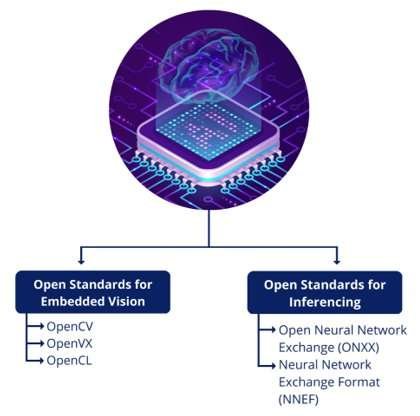By Ambuj Nandanwar, Softnautics
Introduction
Embedded Vision and Inferencing are two critical technologies for many modern devices such as drones, autonomous cars, industrial robots, etc. Embedded vision uses computer vision to process images, video, and other visual data, while inferencing is the process of making decisions based on collected data without having to explicitly program each decision step with the help of diverse architectures and platforms including multi-core ARM, DSP, GPUs, and FPGAs to provide a comprehensive foundation for developing multimedia systems. Open standards are essential to the development of interoperable systems, and they allow for transparency in the development process while providing a level playing field for all participants.
The global market for embedded vision and inferencing was valued at USD 11.22 billion in 2021, with a compound annual growth rate (CAGR) of around 7% from 2022 to 2030. It’s worth noting that the market share for embedded vision and inferencing is likely to continue evolving rapidly as these technologies are becoming increasingly pivotal for next-gen solutions across industries.
Adoption of Open Standards
Open Standards have been widely adopted by the industry, with many companies adopting them as their default. The benefits of open standards are numerous and include:
- Reduced cost for development and integration
- Increased interoperability between systems and components
- Reduced time to market
Open Standards for Embedded Vision
Open standards for embedded vision are a critical component of the Internet of Things (IoT). They provide a common language that allows devices to communicate with each other, regardless of manufacturer or operating system. Open standards for embedded vision include OpenCV, OpenVX, and OpenCL.
OpenCV is a popular open-source computer vision library that includes over 2,500 optimized algorithms for image and video analysis. It is used in applications such as object recognition, facial recognition, and motion tracking. OpenVX is an open-standard API for computer vision that enables performance and power-optimized implementation, reducing development time and cost. It provides a common set of high-level abstractions for applications to access hardware acceleration for vision processing. OpenCL is an open standard for parallel programming across CPUs, GPUs, and other processors that provides a unified programming model for developing high-performance applications. It enables developers to write code that can run on a variety of devices, making it a popular choice for embedded vision applications.

Open Standards for Embedded Vision & Inferencing
Open Standards for Inferencing
Open standards for inferencing are also essential for the development of intelligent systems. One of the most important open standards is the Open Neural Network Exchange (ONNX), which describes how deep learning models can be exported and imported between frameworks. It is currently supported by major frameworks like TensorFlow, PyTorch, and Caffe2.
ONNX enables interoperability between deep learning frameworks and inference engines, which is critical for the development of intelligent systems that can make decisions based on collected data. It provides a common format for representing deep learning models, making it easier for developers to build and deploy models across different platforms and devices.
Another important open standard for inferencing is the Neural Network Exchange Format (NNEF), which enables interoperability between deep learning frameworks and inference engines. It provides a common format for deploying and executing trained neural networks on various devices. It allows developers to build models using their framework of choice and deploy them to a variety of devices, making it easier to build intelligent systems that can make decisions based on collected data.
Future of Open Standards
The future of open standards for embedded vision and inferencing is bright, but there are challenges ahead. One of the biggest challenges is the lack of support for open-source software in embedded systems. This means that open-source libraries and frameworks cannot be used on devices with limited memory and processing power. Another challenge is the wide variety of processors and operating systems available, making it difficult to create a standard that works across all devices. However, there are initiatives underway like hardware innovation and algorithm optimization to address these challenges.
Industry Impact of Open Standards
Open standards have a significant impact on the industry and consumers. The use of open standards has enabled an ecosystem to develop around machine learning and deep learning algorithms, which is essential for innovation in this space. Open-source software has been instrumental in accelerating the adoption of AI across industries, including automotive, consumer, financial services, manufacturing, and healthcare.
Open standards also have a direct impact on consumers by lowering costs, increasing interoperability, and improving security across devices. For example, standards enable companies to build products using fewer components than proprietary solutions require, reducing costs for manufacturers and end-users who purchase products with embedded vision technology built-in (e.g., cameras).
Open Standards are the key to unlocking the full potential of embedded vision and inferencing. They allow developers to focus on their applications, rather than on the underlying hardware or software platforms. Open standards also provide a level playing field for all types of companies – from startup to large enterprises – to compete in this growing market. Overall, open standards are crucial for unlocking the full potential of embedded vision and inferencing for designing next-gen solutions across various industries.
Post Disclaimer
The information provided in our posts or blogs are for educational and informative purposes only. We do not guarantee the accuracy, completeness or suitability of the information. We do not provide financial or investment advice. Readers should always seek professional advice before making any financial or investment decisions based on the information provided in our content. We will not be held responsible for any losses, damages or consequences that may arise from relying on the information provided in our content.



